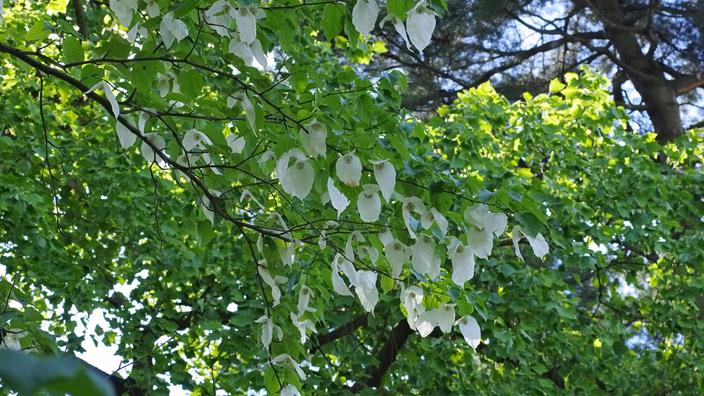Latin name
:
Davidia involucrata
To discover
True or false: fight misconceptions about the garden
Family
: Nyssaceae.
What are the origins of the tissue tree?
Origin:
This amazingly flowering tree was discovered in China in the spring of 1869, by Father Armand David, Vincentian missionary and eminent botanist (hence its name
Davidia
).
But the first seeds were only sent to France in 1897, so it was not until 1906 that the first specimen bloomed on our continent.
Main types
: The handkerchief tree is the only representative of its botanical genus.
We can cite a few cultivars created by man: 'Lady Sunshine', 'Sonoma' or 'Vilmoriniana'.
Read alsoWhich tree to plant for shade in summer?
What are the characteristics of the tissue tree?
Davidia involucrata
is a beautiful deciduous tree growing 10 to 20 m tall when fully grown.
Oval in shape, the green leaves, toothed at the margins and pointed at the end, are carried by a red petiole.
They are reminiscent of those of lime or mulberry.
But it is above all its flowers or more precisely its bracts that give it all its originality.
These highly developed organs, oblong in shape and yellowish then white in color, indeed look like hanging tissues or paper pouches.
Measuring 20 cm long, they surround at their base a small inflorescence made up of male flowers, recognizable by their dark red anthers (sacs containing pollen), or female but also hermaphroditic.
Once fertilized, these give way to globular fruits, brown when ripe, about 2 cm in diameter.
Growth
: Note that if you plant a tissue tree in your garden, you will have to wait 15 to 20 years before seeing it bloom for the first time.
Flowering period:
May to June.
Hardiness:
Although it resists cold well (down to -20°C),
Davidia involucrata
is, on the other hand, sensitive to spring frosts, cold winter winds and summer drought.
Read the fileOUR DOSSIER - Decorative trees and shrubs: our advice on planting and maintenance
The handkerchief tree is sensitive to spring frosts, cold winter winds and summer drought.
adobe-stock
How to grow the tissue tree?
Level of difficulty:
Very easy.
Soil:
The handkerchief tree needs acidic or calcareous, humus-rich, rich and cool soil.
Exposure:
Sun to partial shade.
Sowing/planting:
Propagation is carried out by cuttings of the eyes in the fall under shelter with suffocation or with dry wood in winter. But you can also sow a mature whole fruit, in a pot or in the ground, which will germinate in the spring of the second year. So after a year and a half...
Cultivation:
Plant your
Davidia
from autumn to spring in a place sheltered from the wind, alone or in a grove associated with other species of trees of comparable size and enjoying the same type of soil.
It does not require any particular care thereafter except to
water it in summer during the first two years
.
Although often grown in a stem, the handkerchief tree naturally has several trunks and the culture in clumps is perfectly suited.
Diseases and parasites:
None to date.
Sheet written by Jean-Marie Souil,
SNHF
, Perennials section

